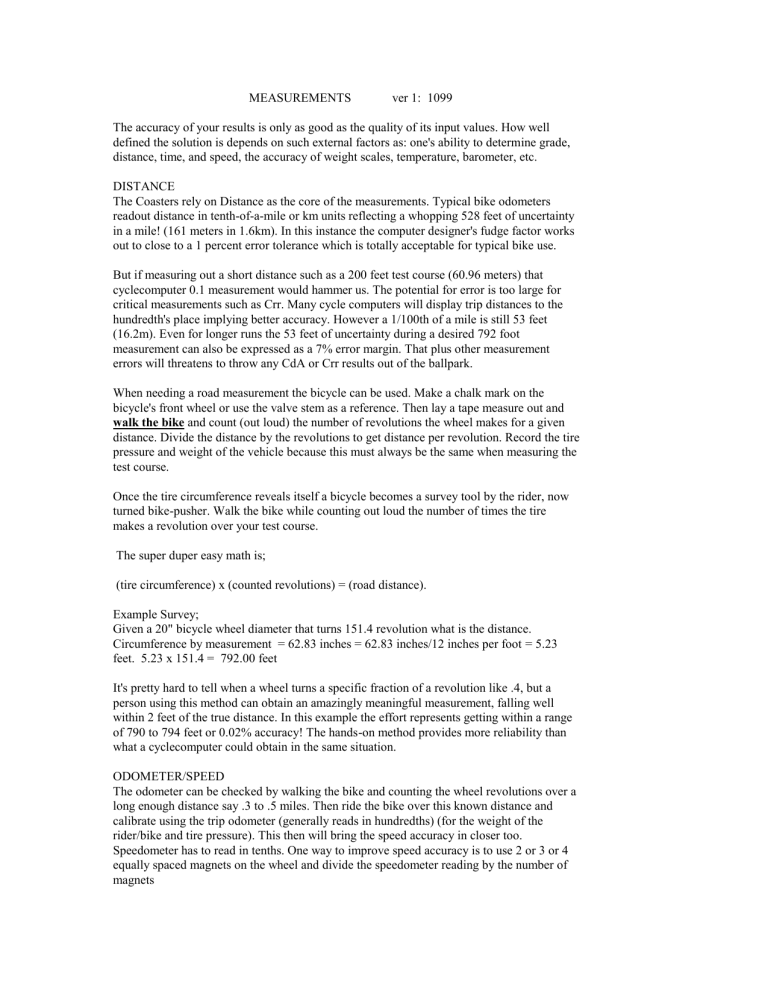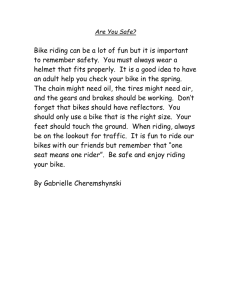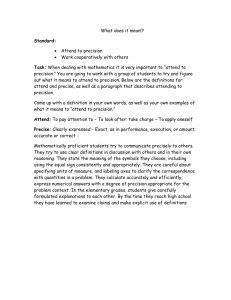An electronic readout of distance in tenth-of-a

MEASUREMENTS ver 1: 1099
The accuracy of your results is only as good as the quality of its input values. How well defined the solution is depends on such external factors as: one's ability to determine grade, distance, time, and speed, the accuracy of weight scales, temperature, barometer, etc.
DISTANCE
The Coasters rely on Distance as the core of the measurements. Typical bike odometers readout distance in tenth-of-a-mile or km units reflecting a whopping 528 feet of uncertainty in a mile! (161 meters in 1.6km). In this instance the computer designer's fudge factor works out to close to a 1 percent error tolerance which is totally acceptable for typical bike use.
But if measuring out a short distance such as a 200 feet test course (60.96 meters) that cyclecomputer 0.1 measurement would hammer us. The potential for error is too large for critical measurements such as Crr. Many cycle computers will display trip distances to the hundredth's place implying better accuracy. However a 1/100th of a mile is still 53 feet
(16.2m). Even for longer runs the 53 feet of uncertainty during a desired 792 foot measurement can also be expressed as a 7% error margin. That plus other measurement errors will threatens to throw any CdA or Crr results out of the ballpark.
When needing a road measurement the bicycle can be used. Make a chalk mark on the bicycle's front wheel or use the valve stem as a reference. Then lay a tape measure out and walk the bike and count (out loud) the number of revolutions the wheel makes for a given distance. Divide the distance by the revolutions to get distance per revolution. Record the tire pressure and weight of the vehicle because this must always be the same when measuring the test course.
Once the tire circumference reveals itself a bicycle becomes a survey tool by the rider, now turned bike-pusher. Walk the bike while counting out loud the number of times the tire makes a revolution over your test course.
The super duper easy math is;
(tire circumference) x (counted revolutions) = (road distance).
Example Survey;
Given a 20" bicycle wheel diameter that turns 151.4 revolution what is the distance.
Circumference by measurement = 62.83 inches = 62.83 inches/12 inches per foot = 5.23 feet. 5.23 x 151.4 = 792.00 feet
It's pretty hard to tell when a wheel turns a specific fraction of a revolution like .4, but a person using this method can obtain an amazingly meaningful measurement, falling well within 2 feet of the true distance. In this example the effort represents getting within a range of 790 to 794 feet or 0.02% accuracy! The hands-on method provides more reliability than what a cyclecomputer could obtain in the same situation.
ODOMETER/SPEED
The odometer can be checked by walking the bike and counting the wheel revolutions over a long enough distance say .3 to .5 miles. Then ride the bike over this known distance and calibrate using the trip odometer (generally reads in hundredths) (for the weight of the rider/bike and tire pressure). This then will bring the speed accuracy in closer too.
Speedometer has to read in tenths. One way to improve speed accuracy is to use 2 or 3 or 4 equally spaced magnets on the wheel and divide the speedometer reading by the number of magnets
TIME
Many bike computer timers register time in hundredths but are not set up for easy access for quick on/off measurements. There are digital watches that are set up for the kind of timing demands we need so this is highly recommended. Timing will be done manually at the beginning and end of a test course, which has a reasonably low potential of errors. Multiple runs generally average out this error. Distance and Time and are the two main standards that the Coasters rely on.
Initial speed is the other main variable. Use a large enough object that is easily seen from a distance (and that be seen out of the corner of the eye) to mark the start and end of the course. The rider can easily see a yellow pylon early enough to be prepared for the start line activities. The start generally consists of looking at the speedometer to see what the initial speed is while looking out of the corner of the eye for the start of the course. The end of the course is simply stopping the timer.
OTHER DETAILS
Weight of vehicle and rider are important. These are easy variables to get quite accurate values. Wherever possible make accurate measurements of easy to measure variables such a distance, weight, temperature, etc. Pay attention to temperature and barometer readings.
Spend some time calibrating you bike odometer/speedometer, and any other devices used to collect the data for the spreadsheets so that the difficult unknowns have a chance to be more accurate.
PAST TECHNIQUES
Many people have attempted to make coasting tests by simply coasting down a grade and recording speed (or distance). Many of the variables are not recorded such as Grade%,
Temperature, Barometer, weights, accurate distance, time, speed. As you become familiar with the TCoasters you will see why these other measuring techniques are fraught with possible errors.
ACCURACY and PRECISION
Most of the numbers that we encounter in everyday life (and science, as well) are not exact numbers but are instead the results of measurements; hence they are only approximate. When you buy “5 gallons” of gasoline for your car, you get only approximately 5 gal, and a “onepound” package of butter contains only approximately 1 lb. Usually we do not worry much about the accuracy of such quantities; we assume that they are close enough for our purposes.
“Accuracy” refers to the truthfulness of the number in an absolute sense. The term precision refers not to the absolute truthfulness of the number but to the degree of effort and care, which was taken in obtaining the number.
In order to see the contrast between the terms “accuracy” and “precision” look at an example:
Consider the “5 gallons” of gasoline you put in your car. The dials on the pump at the service station can easily be read to the nearest one-tenth of a gallon. (The line or graduations on the right-hand dial are apart.) Thus without any great effort the amount of gasoline delivered can seen, “apparently”, to be 5.0 gal, not 5.1 or 4.9 gal. The measurement of the volume of gasoline delivered into your tank can be said to be precise to the nearest 0.1 gal; that is, the number 5.0 has a precision of 0.1. With a little care the space between two adjacent graduations on the “one-tenth gallon”, or right hand, dial on the pump can be divided up into 10 imaginary spaces, and the flow of gasoline can be stopped so that a little more than 5.0 gal has been delivered. Estimate (using our imaginary subdivisions on the dial) that 5.02 gal have been delivered. Reading the dial this carefully has allowed us to specify the volume of gasoline delivered to the nearest 0.01 gallon, an increase in the precision of the measurement.
Does high precision always-mean high accuracy? Not always. Suppose that the measurement device in the gasoline pump were defective so that the pump delivered only about 4 gal of gas when the meter read 5.02 gal. In this (unlikely) event the precision of the last measurement would still be very high (one-hundredth of a gallon), but the accuracy would be very low (only about 1 gal).
The collecting of data to be used with the spreadsheets can be highly precise, however it is not very accurate. The accuracy limitation fall into two categories, first and foremost data collection tools and test condition imposed inaccuracies.
Since each number we encounter (with a few exceptions, to be discussed below) is either directly or indirectly the result of a measurement, and since each is therefore limited in its precision, it is useful to know that precision. There are several different ways for expressing the precision inherent in a number, but the simplest and most commonly used is the method whereby the number of significant figures in the number shows the relative precision of the number itself. Compare for example, the numbers 5.32 and 5.3. The number 5.32 is expressed to the nearest 0.01; its precision is 0.01 part in 5.32 parts, or (0.01/5.32) X 100 =
0.2 percent. (Note that the position of the decimal point has no effect on the determination of precision.)
Significant figures, or significant digits, as they are often called, are digits which serve to establish the value of the number; zeros shown merely to locate the decimal point are NOT significant figures. Thus, the number 4.56 have three significant figures, and so does the number 0.00456. In each of these cases the 4, the 5, and the 6 are the significant figures; in the second example the two zeros just to the right of the decimal point are only place markers. (The zero on the far left is not necessary at all; it is often written, however, for the purpose of alerting the reader that a decimal point is lurking around somewhere.)
When a number is written correctly a rule usually followed is that the last significant figure
(on the right) is the one that may be somewhat uncertain or doubtful. This means, for example, that in the number 4.56 the 4 and the 5 are known with certainty, but there is some doubt about the 6. The 6 is still specified, however, and what this really means is that the most probable value of the last digit is 6.
FUTURE POSSIBILITIES
A coaster spreadsheet along with a laptop could be used at a HPV competition. The competition timing equipment could be used to give much better accuracy. The process could be included as a calibration event before the races to determine Crr and CdA values (late evening or early morning at zero wind conditions). This data could then be used as a way to make comparisons between vehicles. This comparison could also indicate the capabilities of the riders. As it is now we can’t tell if it’s the vehicle or the rider.








